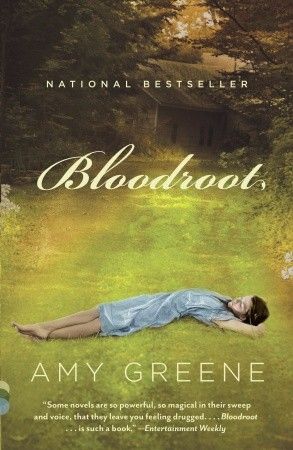TW: Abuse and depictions of violence
Amy Greene’s debut novel, Bloodroot, is a striking work of literary fiction set in the Appalachian region of Tennessee. Rather than following a traditional plot, Bloodroot is a collection of life stories spanning four generations, each narrator connected to the novel’s central figure: Myra Lamb. By progressing in a non-linear fashion, Bloodroot’s character-driven storytelling allows readers to slowly navigate the depths of this tragic family. This is largely achieved through coupled perspectives, the first alternating between Myra’s childhood friend, Doug, and her grandmother, Birdie; and later shifting to Myra’s own children, Johnny and Laura. Though these stories are brought together by their connection to Myra, I found each incredibly compelling in its own right.
From her magical childhood on Bloodroot Mountain, to the development of her toxic relationship with the charming John Odom and her return to the mountain as a mother, Myra’s story is revealed in tantalizing pieces, emphasizing the enigma that is her character. For about two-thirds of the book, Myra’s true story and motives remain a mystery. Utilizing this ambiguity, Greene introduces some mystery genre conventions, most notably the conspicuous absence of the abusive John Odom and a suspicious finger bone in a box found by Myra’s children. However, Bloodroot appears less concerned with fleshing out these mysteries and more with using them to develop themes and character dynamics.
Fans of Magical Realism and Southern Gothic literature will be drawn to this novel, as Greene expertly balances the magic of Appalachian folk tradition with unflinching realism and potent authenticity. Myra’s “granny women” ancestors possess supernatural gifts, some of which seem to have resurfaced in Myra and her children. Likewise, evil spirits abound in this world, with chicken hearts capable of producing all-consuming love, and Myra’s “haint blue eyes” signifying the supposed end of a generational curse. These abilities, known to the residents of Bloodroot Mountain as “the touch,” are by no means portrayed as rural sensibilities to be gawked at. Instead, they feel as natural as the gritty realism which permeates the novel.
Rather than the aristocracies and crumbling Southern mansions one might associate with the Southern Gothic, Bloodroot immerses you in a world of generational poverty, regional dialects, and natural landscapes so vibrant they become characters in their own right. Greene’s status as a Tennessee native is on full display in her loving depiction of the region and those who populate it, capturing the magic without overly sensationalizing the real people or places her inspiration stems from. This authenticity, I believe, is Greene’s greatest strength.
It wouldn’t be fair to discuss this novel without mentioning its absolutely heartbreaking tone. Bloodroot is a story that gets under people’s skin, and I was no exception. While I certainly understand critiques of the immense tragedy this book seems to thrust upon its characters, I found it to be a compelling facet of Greene’s realism. Rather than relying on melodrama and tired, tear-jerking plots, Greene manages to imbue a deep sense of melancholy into this work. Multiple characters elicited emotional responses, yet I never felt like Greene was setting out to write a “sad book,” at least not in the traditional sense. The melancholia of this work stems from realism, whether in the separation of families or untimely deaths of good people; many of the characters’ struggles stem from the larger systemic issues they face living in rural poverty.
While Bloodroot contains some truly beautiful prose, largely due to Greene’s more literary aspirations with this work, I believe it is ultimately very accessible and capable of drawing in most readers. Some narrators stood out to me more than others, yet the sections which succeeded did so thoroughly, absolutely engrossing me in the work. Although the tragedy at every turn might be a detractor for some, there’s something beautiful and inexplicable about this book which really captivated me. In her profound portrayal of generational traumas, Greene masterfully demonstrates the sharp ferocity of love and the pain it brings.
Rating: 4 of 5 stars

